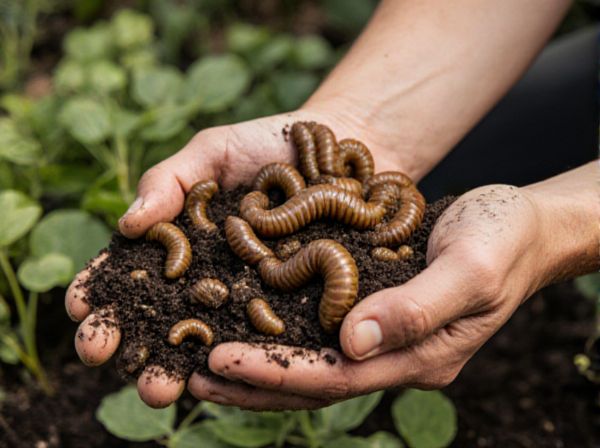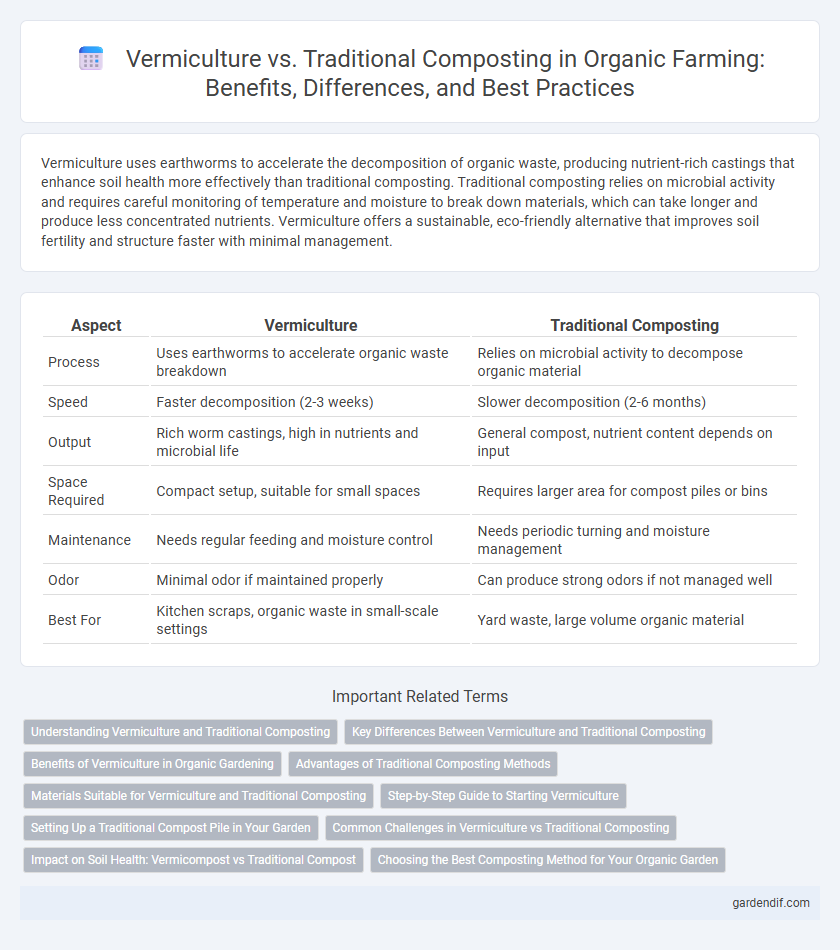
Vermiculture vs Traditional Composting Illustration
Vermiculture uses earthworms to accelerate the decomposition of organic waste, producing nutrient-rich castings that enhance soil health more effectively than traditional composting. Traditional composting relies on microbial activity and requires careful monitoring of temperature and moisture to break down materials, which can take longer and produce less concentrated nutrients. Vermiculture offers a sustainable, eco-friendly alternative that improves soil fertility and structure faster with minimal management.
Table of Comparison
| Aspect | Vermiculture | Traditional Composting |
|---|---|---|
| Process | Uses earthworms to accelerate organic waste breakdown | Relies on microbial activity to decompose organic material |
| Speed | Faster decomposition (2-3 weeks) | Slower decomposition (2-6 months) |
| Output | Rich worm castings, high in nutrients and microbial life | General compost, nutrient content depends on input |
| Space Required | Compact setup, suitable for small spaces | Requires larger area for compost piles or bins |
| Maintenance | Needs regular feeding and moisture control | Needs periodic turning and moisture management |
| Odor | Minimal odor if maintained properly | Can produce strong odors if not managed well |
| Best For | Kitchen scraps, organic waste in small-scale settings | Yard waste, large volume organic material |
Understanding Vermiculture and Traditional Composting
Vermiculture utilizes earthworms to accelerate the decomposition of organic waste, producing nutrient-rich castings that enhance soil fertility more effectively than traditional composting. Traditional composting relies on microbial activity to break down organic matter, requiring regular turning and longer processing times to achieve mature compost. Understanding the biological mechanisms and environmental conditions that favor vermiculture or traditional composting helps optimize nutrient recycling and organic waste management.
Key Differences Between Vermiculture and Traditional Composting
Vermiculture utilizes specific worm species, such as Eisenia fetida, to accelerate the decomposition of organic waste into nutrient-rich castings, enhancing soil fertility more efficiently than traditional composting. Traditional composting relies on microbial activity and aerobic processes to break down organic matter over weeks or months, often requiring larger space and more maintenance. Vermiculture produces a faster, more odorless, and higher-quality end product, making it ideal for small-scale or urban organic waste management.
Benefits of Vermiculture in Organic Gardening
Vermiculture enhances organic gardening by accelerating nutrient cycling through the action of earthworms, which produce nutrient-rich castings that improve soil structure and fertility. This method supports better plant growth by increasing microbial activity and promoting aeration, resulting in higher yields compared to traditional composting. Unlike traditional compost, vermicompost retains more nitrogen and essential trace minerals, making it a superior organic fertilizer for sustainable garden health.
Advantages of Traditional Composting Methods
Traditional composting methods offer a robust and scalable solution for organic waste management, leveraging aerobic decomposition to produce nutrient-rich humus that enhances soil fertility. These methods promote biodiversity by supporting a wide range of microorganisms and earthworms, which accelerate the breakdown of organic matter and improve soil structure. Their simplicity and adaptability make them accessible for large-scale agricultural applications and community composting initiatives.
Materials Suitable for Vermiculture and Traditional Composting
Vermiculture thrives on nitrogen-rich kitchen scraps like fruit peels, vegetable waste, coffee grounds, and crushed eggshells, alongside shredded cardboard or paper to balance carbon content. Traditional composting accommodates a broader range of materials, including yard waste, grass clippings, woody branches, and livestock manure, blending green and brown materials to promote microbial activity. Both methods benefit from avoiding processed foods, oils, and meat products to prevent odors and pests.
Step-by-Step Guide to Starting Vermiculture
Begin vermiculture by selecting a suitable container, such as a plastic or wooden bin with air holes for ventilation, ensuring a moist but not soggy bedding medium made from shredded newspaper or coconut coir. Introduce red wigglers (Eisenia fetida) to the bedding and add kitchen scraps like fruit and vegetable peels, avoiding meat and dairy to prevent odors and pests. Maintain optimal conditions by regularly turning the compost, monitoring moisture levels, and harvesting nutrient-rich worm castings every few months to enhance soil fertility naturally.
Setting Up a Traditional Compost Pile in Your Garden
Setting up a traditional compost pile in your garden involves selecting a well-drained, shaded area to balance moisture and airflow for optimal decomposition. Layering green materials like vegetable scraps with brown materials such as dry leaves and straw accelerates microbial activity, enriching the compost. Regular turning of the pile promotes oxygen circulation, reduces odors, and speeds up the breakdown of organic matter into nutrient-rich soil amendment.
Common Challenges in Vermiculture vs Traditional Composting
Vermiculture often struggles with maintaining optimal moisture and temperature levels for worm health, while traditional composting faces challenges in balancing carbon-to-nitrogen ratios to accelerate decomposition. Pest infestations, such as fruit flies, are common in vermiculture due to exposed organic matter, whereas traditional compost piles may attract rodents without proper management. Both methods require consistent monitoring to prevent foul odors, yet vermiculture demands more delicate handling to sustain worm populations.
Impact on Soil Health: Vermicompost vs Traditional Compost
Vermiculture significantly enhances soil health by introducing nutrient-rich vermicompost teeming with beneficial microbes, which improve soil structure, aeration, and water retention. Traditional composting provides organic matter that enriches soil fertility but often lacks the concentrated microbial activity found in vermicompost. The increased microbial diversity in vermiculture accelerates nutrient cycling, boosting plant growth and soil resilience more effectively than conventional compost methods.
Choosing the Best Composting Method for Your Organic Garden
Vermiculture enhances soil fertility by utilizing earthworms to break down organic waste more efficiently than traditional composting, resulting in nutrient-rich worm castings that promote plant growth. Traditional composting requires larger space and longer decomposition times but effectively manages diverse organic materials, balancing carbon and nitrogen ratios for healthy soil amendment. Selecting the best composting method depends on available space, composting speed preferences, and the type of organic waste generated in your garden.
Vermiculture vs Traditional Composting Infographic

 gardendif.com
gardendif.com